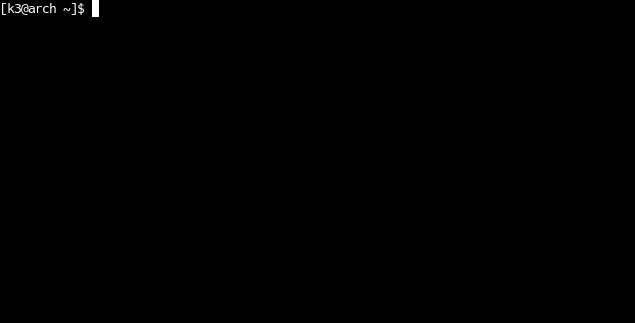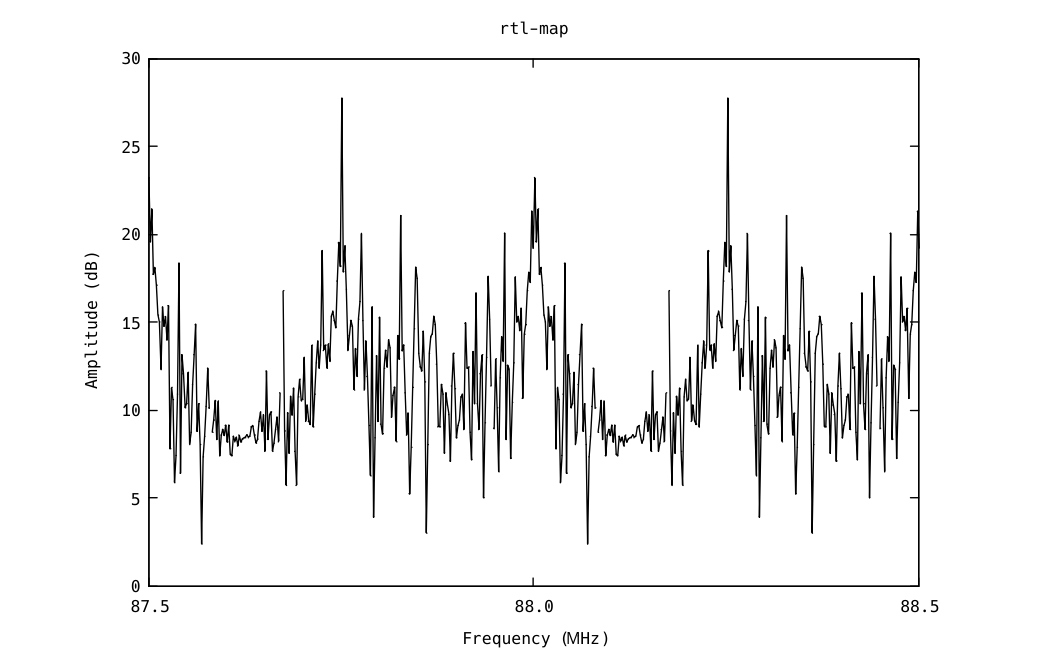https://github.com/orhun/rtl_map
FFT-based visualizer for RTL-SDR devices. (RTL2832/DVB-T)
https://github.com/orhun/rtl_map
fft r820t radio rtl-sdr rtl2832u sdr visualizer
Last synced: 6 months ago
JSON representation
FFT-based visualizer for RTL-SDR devices. (RTL2832/DVB-T)
- Host: GitHub
- URL: https://github.com/orhun/rtl_map
- Owner: orhun
- License: gpl-3.0
- Created: 2019-01-21T21:44:27.000Z (over 6 years ago)
- Default Branch: master
- Last Pushed: 2023-01-01T16:22:35.000Z (almost 3 years ago)
- Last Synced: 2025-04-16T00:07:33.335Z (6 months ago)
- Topics: fft, r820t, radio, rtl-sdr, rtl2832u, sdr, visualizer
- Language: C
- Homepage:
- Size: 80.1 KB
- Stars: 80
- Watchers: 12
- Forks: 13
- Open Issues: 3
-
Metadata Files:
- Readme: README.md
- Funding: .github/FUNDING.yml
- License: LICENSE
Awesome Lists containing this project
README
### FFT-based visualizer for RTL-SDR devices. (RTL2832/DVB-T)

DVB-T dongles based on the `Realtek RTL2832U` can be used as a cheap SDR (_Software-defined radio_), since the chip allows transferring the raw I/Q (_In-phase / Quadrature_) samples to the host, which is officially used for DAB/DAB+/FM demodulation.
([More about history & discovery of rtl-sdr](http://rtlsdr.org/#history_and_discovery_of_rtlsdr))
There is various software for DSP (_Digital signal processing_), spectral analysis and signal intelligence using RTL-SDR such as [SDR#](https://airspy.com/download/), [gqrx](http://gqrx.dk/) and [gnuradio](https://www.gnuradio.org/).
Apart from these, there is [librtlsdr](https://github.com/steve-m/librtlsdr) which most of the user-level packages rely because of the reason that librtlsdr comes as a part of the rtl-sdr codebase.
This codebase contains both the library itself and also a number of command line tools such as rtl_test, rtl_sdr, rtl_tcp, and rtl_fm for testing RTL2832 and performing basic data transfer functions.
Therefore, librtlsdr is one of the major tools in RTL-SDR community.
Most of the technically questions RTL-SDR enthusiasts ask is about reading samples from device and processing raw I/Q samples. I wanted to answer that kind of questions and demonstrate a implementation of this with `rtl_map project` which is built on top of librtlsdr. Also, I went a step further and added graph feature that creates amplitude (dB) - frequency (MHz) graph using [gnuplot](http://www.gnuplot.info/) and [FFT](https://en.wikipedia.org/wiki/Fast_Fourier_transform) (_Fast Fourier transform_) algorithm. ([fftw](http://www.fftw.org/) used for this approach) I can list other useful open-source projects as [#1](https://gist.github.com/creaktive/7eeaeb76de26ca39dc3f), [#2](https://github.com/xofc/rtl_fftmax) and [#3](https://github.com/roger-/pyrtlsdr).
Another purpose of this project is making a testing tool & frequency scanner application for security researches.
[https://www.rtl-sdr.com/rtl_map-a-simple-fft-visualizer-for-rtl-sdr/](https://www.rtl-sdr.com/rtl_map-a-simple-fft-visualizer-for-rtl-sdr/)
## Installation
### Dependencies
* libusb1.0 (development packages must be installed manually, see [libusb.info](https://libusb.info/))
* gnuplot (must be installed manually, see [installation page](http://gausssum.sourceforge.net/DocBook/ch01s03.html))
* librtlsdr (cmake / automatic installation & linking)
* fftw3 (cmake / automatic installation & linking)
### Clone Repository
```
git clone https://github.com/orhun/rtl_map
```
### Building with CMake (recommended)
```
cd rtl_map
mkdir build
cd build
cmake ../
make
sudo make install
sudo ldconfig
```
### Building with GCC
```
gcc rtl_map.c -o rtl_map -lrtlsdr -lfftw3 -lm
```
## Usage
### Command Line Arguments
```
-d, set device index (default: 0)
-s, set sample rate (default: 2048000 Hz)
-f, center frequency (Hz) [mandatory argument]
-g gain (0 for auto) (default: ~1-3)
-n number of reads (default: int_max.)
-r, refresh rate for continuous read (default: 500ms)
-D, don't show gnuplot graph (default: show)
-C, continuously read samples (default: off)
-M, show magnitude graph (default graph: dB)
-O, disable offset tuning (default: on)
-T, turn off terminal log colors (default: on)
-h, show help message and exit
filename (a '-' dumps samples to stdout)
```
### Example: Print samples to file
```
[k3@arch ~]$ rtl_map -f 88000000 -D capture.dat
[01:00:26] INFO Starting rtl_map ~
[01:00:26] INFO Found 1 device(s):
[01:00:26] INFO #0: Generic RTL2832U OEM
Found Rafael Micro R820T tuner
[01:00:27] INFO Using device: #0
[01:00:27] INFO Gain set to 14.
Supported gain values (29): 0.0 0.9 1.4 2.7 3.7 7.7 8.7 12.5 14.4 15.7 16.6 19.7 20.7 22.9 25.4
128.0 29.7 32.8 33.8 36.4 37.2 38.6 40.2 42.1 43.4 43.9 44.5 48.0 49.6
[01:00:27] INFO Center frequency set to 88000000 Hz.
[01:00:27] INFO Sampling at 2048000 S/s
[01:00:27] INFO Reading samples...
[01:00:27] INFO Done, exiting...
```
### Example: Print samples to stdout
```
rtl_map -f 88000000 -D -
```

### Example: Print 10x512 samples to stdout
```
rtl_map -f 88000000 -D -C -n 10 -
```
### Example: Create FFT graph from samples
```
[k3@arch ~]$ rtl_map -f 88000000
[01:00:28] INFO Starting rtl_map ~
[01:00:28] INFO Found 1 device(s):
[01:00:28] INFO #0: Generic RTL2832U OEM
Found Rafael Micro R820T tuner
[01:00:28] INFO Using device: #0
[01:00:28] INFO Gain set to 14.
Supported gain values (29): 0.0 0.9 1.4 2.7 3.7 7.7 8.7 12.5 14.4 15.7 16.6 19.7 20.7 22.9 25.4
28.0 29.7 32.8 33.8 36.4 37.2 38.6 40.2 42.1 43.4 43.9 44.5 48.0 49.6
[01:00:29] INFO Center frequency set to 88000000 Hz.
[01:00:29] INFO Sampling at 2048000 S/s
[01:00:29] INFO Creating FFT graph from samples using gnuplot...
[01:00:29] INFO Done, exiting...
```

### Example: Continuously read samples and create FFT graph
```
rtl_map -f 88000000 -C -r 100
```

## DC Offset & I/Q Imbalance
There is a common issue with cheap RTL-SDR receivers which is `center frequency spike` or `central peak` problem related to I/Q imbalance. This problem can be solved with a implementation of some algorithms. (For more details: [#1](https://github.com/roger-/pyrtlsdr/issues/94), [#2](https://wiki.analog.com/resources/eval/user-guides/ad-fmcomms1-ebz/iq_correction))
## TODO(s)
1. Implement I/Q correction
2. Find the maximum value of samples, show it on graph with a different color. Might be useful for frequency scanner.
3. Frequency scanner feature
4. Check correctness of min/max point calculation.
5. Check correctness of amplitude (dB) calculation.
* 820T2 tuner used for testing. Other RTL-SDR devices must be tested.
## Contribution
You can contribute to this project if you are a RTL-SDR enthusiast or researcher. Fork the repository and start coding.
I hope some people on this planet will consider my TODO(s) and help me build the frequency scanner tool :)
## License
GNU General Public License ([v3](https://www.gnu.org/licenses/gpl.txt))
## Copyright
Copyright (c) 2019-2023, [orhun](https://www.github.com/orhun)





